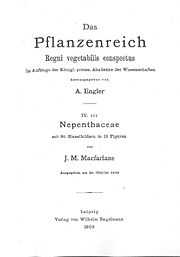Nepenthaceae (1908 monograph)



"Nepenthaceae" is a monograph by John Muirhead Macfarlane on the tropical pitcher plants of the genus Nepenthes.[1] It was published in 1908 in Adolf Engler's Das Pflanzenreich.[1] It was the most exhaustive revision of the genus up to that point, covering all known species, and included detailed accounts of the structure, anatomy, and development of Nepenthes.[1]
Content
Macfarlane recognised 58 species, including 8 newly described ones: N. anamensis (later synonymised with N. smilesii),[2][3] N. beccariana, N. copelandii, N. deaniana, N. hemsleyana, N. neglecta (possibly the natural hybrid between N. gracilis and N. mirabilis),[4] N. philippinensis, and N. tubulosa (later synonymised with N. mirabilis).[2][5] Macfarlane also described a number of new varieties, including N. alata var. biflora (later synonymised with N. negros),[6] N. alata var. ecristata (later synonymised with N. kurata),[7] N. albomarginata var. rubra, N. hirsuta var. glabrata, N. hirsuta var. typica, N. tentaculata var. tomentosa, and N. vieillardii var. montrouzieri.[8] The varietal name N. gracilis var. arenaria, originating from a herbarium sheet, also appeared in print for the first time in Macfarlane's monograph.[8] The work included all manmade hybrids known at the time.[1]
Macfarlane synonymised a number of species, including N. korthalsiana with N. gracilis, N. macrostachya with N. mirabilis, N. sumatrana with N. treubiana (later reversed),[9] and both N. teysmanniana and N. tomentella with N. albomarginata.[1][10] Macfarlane restored N. edwardsiana as a species distinct from N. villosa.[1] This decision was reversed by B. H. Danser in his 1928 work, "The Nepenthaceae of the Netherlands Indies",[5] but is universally accepted today.[2]
Macfarlane recognised N. × cincta as a natural hybrid between N. albomarginata and N. northiana, and N. × harryana as a natural hybrid between N. edwardsiana and N. villosa.[1]
Species
The following 58 taxa are enumerated and detailed in Macfarlane's "Nepenthaceae". Varieties recognised by Macfarlane are also included. Taxon names are listed as they appear in the monograph, including orthographic variants, though specific epithets derived from proper nouns have been decapitalised.
- N. alata
- var. biflora
- var. ecristata
- N. albo-lineata
- N. albo-marginata
- var. rubra
- var. villosa
- N. alicae
- N. ampullaria
- var. geelvinkiana
- var. longicarpa
- N. anamensis
- N. angustifolia
- N. armbrustae
- N. beccariana
- N. bernaysii
- N. bicalcarata
- N. blancoi
- N. bongso
- N. boschiana
- N. burbidgei [sic]
- N. burkei
- var. excellens
- var. prolifica
- N. cholmondeleyi
- N. copelandii
- N. deaniana
- N. distillatoria
- N. echinostoma
- N. edwardsiana
- N. eustachya
- N. garrawayae
- N. gracilis
- N. hemsleyana
- N. hirsuta
- var. glabrata
- var. typica
- N. hookeriana
- N. jardinei
- N. kennedyana
- N. khasiana
- N. lowii
- N. macfarlanei
- N. madagascariensis
- N. maxima
- N. melamphora
- var. haematamphora
- var. tomentella
- N. moorei
- N. neglecta
- N. northiana
- N. pervillei
- N. philippinensis
- N. phyllamphora
- N. rafflesiana
- var. minor
- var. nigro-purpurea
- var. nivea
- N. rajah
- N. reinwardtiana
- N. rowanae
- N. sanguinea
- N. singalana
- N. smilesii
- N. stenophylla
- N. tentaculata
- var. imberbis
- var. tomentosa
- N. treubiana
- N. trichocarpa
- N. tubulosa
- N. veitchii
- N. ventricosa
- N. vieillardii
- var. deplanchei
- var. montrouzieri
- N. villosa
- Nomina nuda v. incerta
- N. cristata
- N. lindleyana
In addition, Macfarlane lists N. gracillima as a possible synonym of N. albomarginata; the species are numbered 7* and 7, respectively.[1]
Reviews and later works
At the time of its publication, "Nepenthaceae" was praised for its many high quality illustrations (95 images in 19 figures) of both morphological and anatomical features.[11]
Research conducted after World War I quickly rendered Macfarlane's monograph outdated.[2] Much additional herbarium material was accumulated during this time, representing both new species and better specimens of known taxa, which highlighted issues with previous interpretations.[4][9] The need for a new revision of the genus was satisfied with the publication of B. H. Danser's seminal 1928 monograph, "The Nepenthaceae of the Netherlands Indies". However, Danser's treatment did not encompass the entire range of the genus. It would not be until Matthew Jebb and Martin Cheek's 1997 monograph, "A skeletal revision of Nepenthes (Nepenthaceae)", that the entire genus was once again revised in a single work.[9]
References
- ↑ 1.0 1.1 1.2 1.3 1.4 1.5 1.6 1.7 Macfarlane, J.M. 1908. Nepenthaceae. In: A. Engler. Das Pflanzenreich IV, III, Heft 36: 1–91.
- ↑ 2.0 2.1 2.2 2.3 McPherson, S.R. 2009. Pitcher Plants of the Old World. 2 volumes. Redfern Natural History Productions, Poole.
- ↑ (Italian) Catalano, M. 2010. Nepenthes della Thailandia: Diario di viaggio. Prague.
- ↑ 4.0 4.1 Clarke, C.M. 1997. Nepenthes of Borneo. Natural History Publications (Borneo), Kota Kinabalu.
- ↑ 5.0 5.1 Danser, B.H. 1928. The Nepenthaceae of the Netherlands Indies. Bulletin du Jardin Botanique de Buitenzorg, Série III, 9(3–4): 249–438.
- ↑ Cheek, M. & M. Jebb 2013. Typification and redelimitation of Nepenthes alata with notes on the N. alata group, and N. negros sp. nov. from the Philippines. Nordic Journal of Botany 31(5): 616–622. doi:10.1111/j.1756-1051.2012.00099.x
- ↑ Cheek, M. & M. Jebb 2013. Recircumscription of the Nepenthes alata group (Caryophyllales: Nepenthaceae), in the Philippines, with four new species. European Journal of Taxonomy 69: 1–23. doi:10.5852/ejt.2013.69
- ↑ 8.0 8.1 Schlauer, J. N.d. Query results: Pflanzenr.36. Carnivorous Plant Database.
- ↑ 9.0 9.1 9.2 Clarke, C.M. 2001. Nepenthes of Sumatra and Peninsular Malaysia. Natural History Publications (Borneo), Kota Kinabalu.
- ↑ Kurata, S. 2002. Revision trial in recent enumeration of Nepenthes species. PDF Proceedings of the 4th International Carnivorous Plant Conference: 111–116.
- ↑ (German) Wangerin, W. 1910. Macfarlane, J. M., Nepenthaceae. In: Lotsy, J.P. (ed.) Botanisches Centralblatt: Referirendes Organ der Association Internationale des Botanistes für das Gesamtgebiet der Botanik. Volume 31, issue 113. Gustav Fischer, Jena. pp. 501–502.
| ||||||||||||||